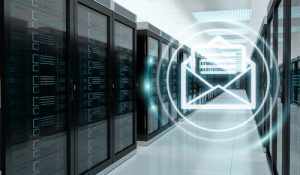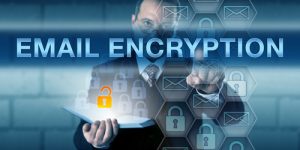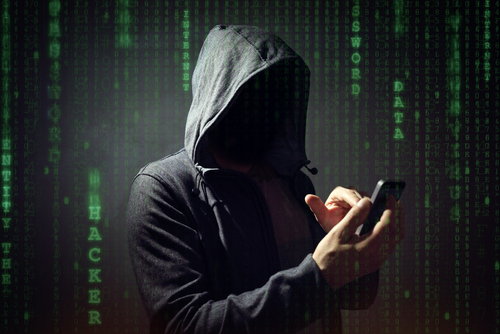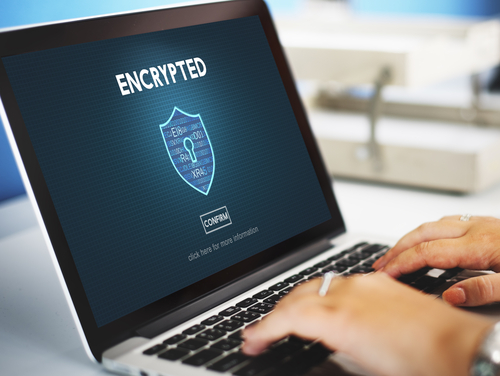Email has become a ubiquitous form of communication. You probably receive and send several of them a day. But, how secure is email? Email is a vulnerable form of communication. It is relatively easy for others to spy, intercept, or scam your email.
So, it’s more important than ever for you to use security best practices while using email. Read on to learn how vulnerable your email is and how you can beef up your email security.

How Does Email Work?
At its essence, email, or electronic mail, is a message transmitted and received through a digital computer network. Text, graphics, sounds, images, documents, and other data can be sent from one inbox to the next. These digital inboxes (hosted by email providers) receive, store, and manage a person’s correspondence.
From this inbox, the user can view, answer, and forward these communications. Email was invented in 1971, but it took a few years for this mode of communication to take off. It has evolved to be a popular form of communication amongst employees in a corporation, but it is also a replacement for physical mail between individuals.
Also, email is essential in how many companies conduct business and marketing. Email operates with Standard Mail Transfer Protocol (SMTP). The original version supported unauthenticated and unencrypted messages.
Although email security has improved somewhat over the years, most service providers do not encrypt messages, leaving your email account open to attacks.
Problems With Standard Email Security
Interestingly enough, the first massive spam email was sent in 1994. So, even in its earliest years, email has been subject to scammers and marketing ploys. Since email was not devised with security in mind, it can be relatively easy for unwanted emails and hackers to find their way into your inbox.
Eavesdropping
Email eavesdropping attacks, or snooping or sniffing attacks, are when there is an interception of information like your passwords, credit card details, or other sensitive data. As your email travels through an unsecured network on its way to the intended recipient, a hacker can tap into the transmission and spy on your communications.
This most frequently happens on public Wi-Fi that anyone can access without a password. However, a lot of email servers are also unsecured, leaving you vulnerable to these types of attacks. Since many email users don’t know about this, they may send sensitive information on these unsecured networks, and criminals use that opportunity to steal their data.
Eavesdropping can also occur when bugs or spy programs are attached to emails or links. If a user clicks on one of these links or opens an attachment, an invisible spy bot can track your internet activity or even give an unauthorized user access to personal data.
If you share a computer with someone else at work, make sure your password is strong because eavesdropping can also occur if someone knows your password. Also, make sure to log out of your account every time you leave your computer to keep others from checking out your emails when you step away.
Phishing Scams
In 2020, there were 241,342 victims of phishing attacks, according to an FBI Internet Crime Report. A phishing attack is when a scammer sends falsified messages trying to trick a recipient into divulging sensitive information. These phishing emails come in the guise of someone you trust, either a company or an acquaintance.
Sometimes they’ll pose as a financial institution needing you to give your username and password for some reason. Then, they’ll use that information to steal from you. Phishing scams are incredibly common because anyone can send you an email as long as they have your email address.
To avoid phishing scams, it’s important to have firewalls installed that scan attachments and links in your emails. Additionally, always verify the identity of the person emailing you before sending confidential information.
Malware Attacks
Malware is software designed to damage, disrupt, or gain access to a computer system. Some types of malware include the following:
- Spyware
- Adware
- Viruses
- Trojans
- Worms
- Ransomware
- Fileless malware
These malicious programs come in many forms. In email, people send malware programs embedded inside email attachments or links inside email messages. If you click on these, the malware causes your computer to download additional malware from the internet.
Once your computer is compromised, hackers can remotely steal your confidential information. There are many programs available to scan for malware to keep your email better protected.
Data Leaks
Our own poor security practices can also lead to leaks in data. There are many ways that people make their emails less secure. For example, if you fail to update apps or operating systems on your devices, you are leaving your system vulnerable.
Updates provide the most modern versions of programs that are better able to stand up to malware and other malicious hacking. Not logging out of your account on shared devices also poses a risk. When another person comes along, they can easily steal your information.
It may seem easier to keep yourself logged into an account you frequently use, but if another person uses that same device, they can access your account and all the data attached to it. Weak passwords also put your email account at risk of getting hacked.
According to statistics released by Google, 52% of users reuse the same password for multiple accounts. These weak passwords are easier for hackers to guess and use to access your accounts. The more emails that you use the same password for, the more accounts a hacker can access if they get that password.
Insecure public WiFi networks also pose a threat of data leaks. It’s hard to know what types of security a public WiFi network has. In addition, you don’t know who is using that network at the same time as you. Sharing sensitive information across these networks leaves your email more vulnerable.
How to Improve Email Security
Luckily, there are ways you can improve your cybersecurity. Upgrading your email client and paying closer attention to their email services will help you to have more secure email.
Be Careful What You Send Via Email
You should always be extra cautious if you choose to share any data via email. But, you should avoid sending the following information via email altogether:
- Usernames
- Passwords
- Credit card information
- Social security numbers
- Driver’s license
Sending this information puts you at further risk of being hacked. People can steal your money and you commit fraud with this information. If you need to send it via email, make sure to take time to encrypt the message and verify the recipient.
Even if you feel like you are being extra cautious, one wrong letter typed in the email address can send your message to the wrong recipient. Check and double-check all your settings before sending any confidential communications.

Encryption
Data encryption refers to the practice of taking your email contents and scrambling them into a random plain text code. It is impossible to decrypt this code without a key. There are different types of encrypted email, with different methods for decoding that information.
Be sure to check to see what type, if any, your email hosting provider has in place. The following are some of the most common:
- Pretty Good Protocol (PGP) Developed in 1991, this popular program is often used to encrypt email. Users have a public key and a private key. The email is sent using the public key. When the recipient opens the message, they use their private key to decode the message. You can download or buy PGP and install it on your computer system.
- Secure/Multipurpose Internet Mail Extensions (S/MIME) encryption can be used with many popular email platforms such as Windows Outlook, Yahoo, and Gmail. This is usually the easiest way to encrypt sensitive emails. It uses a unique certificate to verify that the email came from the person it says it is. The message gets encrypted using a public key. Then, the user uses their private key to decrypt the message.
- Transport Layer Security (TLS) or Secure Socket Layers (SSL are protocols for encrypting data while it is in transit. TLS is a more modern version of SSL. TLS protocol uses a combination of symmetric and asymmetric cryptography to encrypt and decrypt data.
- End-to-end encryption is the process of encrypting email before it leaves your device, during transport, and only decrypting it once it arrives at its intended recipient with a private key. This is the best type of encryption and offers the most complete security.
However, as great as encryption is, many users shy away from it because it is too complicated. It requires both a sender and recipient to use and exchange keys securely. Although it may seem difficult, if you are regularly sending emails with confidential information, it may be in your best interest to learn how to send encrypted emails.
Multi-Factor Authentication
Another level of security you can add to your email communication is multi-factor authentication (MFA) or two-factor authentication (2FA). In this form of security, a user must enter their password to access a file. Then, a passcode is sent to their cell phone for further authentication. This passcode expires in a short time frame.
2FA is great at deterring scammers. Even if they can get through one layer of authentication, they are usually unable to get through the second. Another way that 2FA works is by asking for biometric identification. This could be face recognition or fingerprints.
Many users find 2FA time-consuming and inconvenient since you need a second form of identification to be able to access your account.
VPN
To ensure secure communication even if you use public WiFi, a VPN, or virtual private network, might be a good choice for you. A VPN is a secure network that obscures your IP address, making it harder for hackers to detect your location. A VPN creates an encrypted tunnel between your device and its server.
Your computer sends a request to the VPN, the VPN then takes that request and sends it to the internet. Now, the website you access sees your location and IP address as that of your VPN server. When you send emails via VPN, you don’t have to take extra steps to protect your emails. They are already secured through the encryption used on the secure network.
VPNs are popular for use while gaming, streaming content, and conducting business on public WiFi. You get added benefits from a VPN if you travel abroad. You can gain access to geo-specific content by using a VPN with an IP address in another country. You can also use this method to get past content blocks on corporate networks.
Sekur Provides Email Security
For more private communications, check out Sekur. Our 100% private platform has encrypted Swiss-hosted email, VPN, and instant messaging services. You can send unlimited-sized attachments and monitor your email activity throughout our secure Swiss environment.
SekurMail sends encrypted emails to both Sekur and non-Sekur users, and our easy email migration tool makes moving from one email provider to another hassle-free. In addition, you can keep anonymous online with Sekur VPN. Our proprietary technology is easy to use and set up.
You only need a single license for all devices. Our VPN is secured using military-grade advanced encryption so you can navigate securely while your IP address is protected. In addition, Sekur Messenger offers you a way to communicate with fully private instant chats that are self-destructing across all devices.
Try our 7-day trial to find out how secure your email communications can be.
Conclusion
Emails are vulnerable to cyberattacks, but you can take steps to secure your communications by investing in data encryption, switching to a VPN, enabling multi-factor authentication, and improving your email best practices.
There are email service providers who prioritize your data security, so be sure to shop around and find the best service provider for your email needs, whether it be for personal or professional use. Then, you can feel safe as you communicate online.

